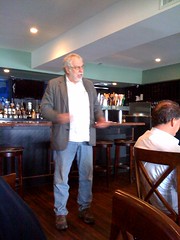
- Image by Keith Allison via Flickr
Let me just repost what Aaron Gleeman wrote yesterday. It should be no surprise to anyone that Joe Mauer is my favorite player in baseball. The guy is a total stud:
Mauer is such a great hitter that batting .417 or getting on base at a .500 clip during a 19-game stretch shouldn’t surprise anyone, but eight homers and five doubles in 72 at-bats is totally unexpected even without considering that he missed April with an injury. He hasn’t abandoned his patient approach at the plate and isn’t suddenly pulling the ball consistently. He’s still taking tons of pitches and going the the other way with most of the balls he hits, but the fly balls just seem to be traveling a little further.
I’m not sure how to explain it and have no idea whether it’ll last, but holy shit has Mauer been amazing. At .417/.500/.819 he’d be leading all of baseball in batting average, on-base percentage, and slugging percentage with enough plate appearances to qualify and he has one homer per 9.0 at-bats after going deep once every 46.8 at-bats coming into the season. Plus, Ron Gardenhire may even leave him in the No. 2 spot that I’ve been advocating for years now after the 20-run outburst with Mauer there yesterday.
![Reblog this post [with Zemanta]](http://img.zemanta.com/reblog_e.png?x-id=11f010b8-924c-40ca-b0ef-9b7c18c67e50)


![Reblog this post [with Zemanta]](http://img.zemanta.com/reblog_e.png?x-id=9a03ea2f-be26-4b25-9762-93614d88184e)

![Reblog this post [with Zemanta]](http://img.zemanta.com/reblog_e.png?x-id=a8ff458a-e390-4223-8524-59d3e2aa230f)



![Reblog this post [with Zemanta]](http://img.zemanta.com/reblog_e.png?x-id=b94d8bb7-bc76-446f-8acb-9f292fe3760f)
 I get Esquire magazine and i have to say that i really like it. The Sports Guy has a rule that he judges how good a magazine is by how long it takes him to read and i have to say that i end up reading Esquire longer than any other mag i get. I probably spend a good hour to 90 minutes on it every month.
I get Esquire magazine and i have to say that i really like it. The Sports Guy has a rule that he judges how good a magazine is by how long it takes him to read and i have to say that i end up reading Esquire longer than any other mag i get. I probably spend a good hour to 90 minutes on it every month. Giant. The history of Texas in the 20th century, as seen through the anguished lonesome eyes of James Dean
Giant. The history of Texas in the 20th century, as seen through the anguished lonesome eyes of James Dean![Reblog this post [with Zemanta]](http://img.zemanta.com/reblog_e.png?x-id=0e5df441-fcda-4d98-abcc-6517658e0019)

![Reblog this post [with Zemanta]](http://img.zemanta.com/reblog_e.png?x-id=af3e12c3-12fe-4533-b9dc-92d9fbba14a8)
 Two of my favorite things are intersecting today. My love for The Sports Guy and for the Timberwolves could turn into a marraige as he’s launching a campaign to be the Twolves GM. The Star Tribune
Two of my favorite things are intersecting today. My love for The Sports Guy and for the Timberwolves could turn into a marraige as he’s launching a campaign to be the Twolves GM. The Star Tribune 